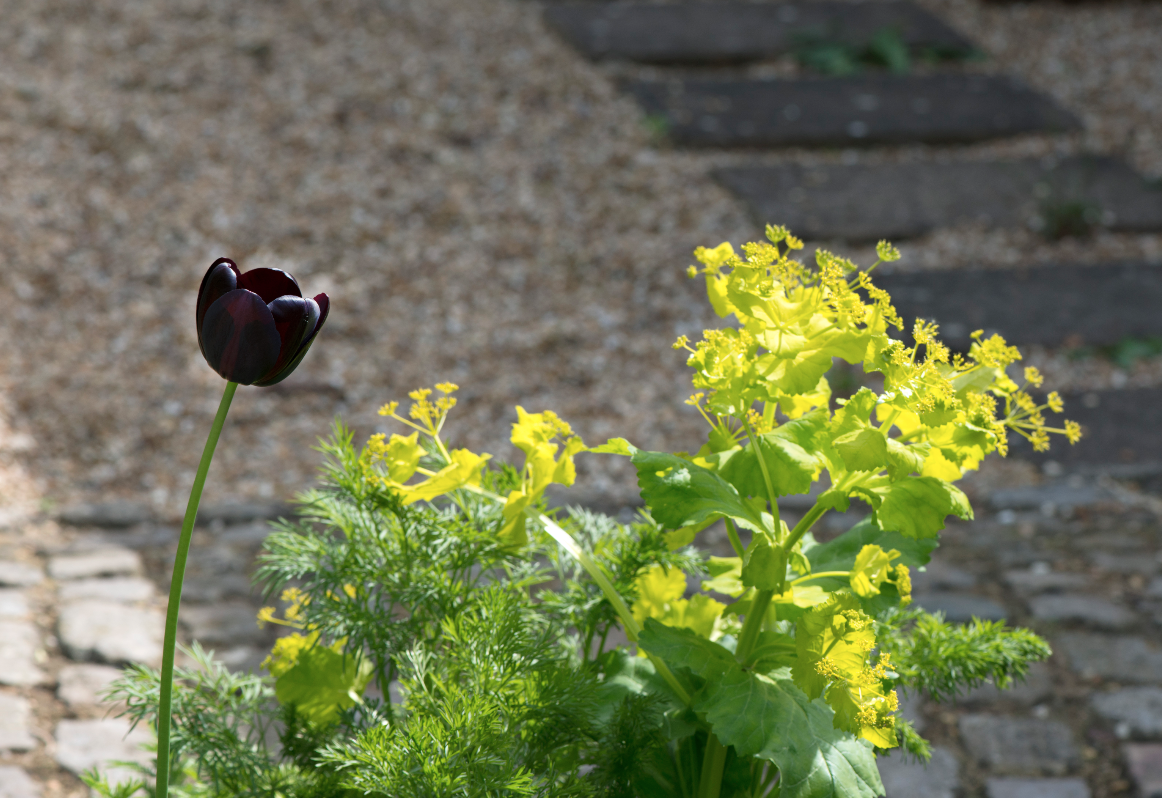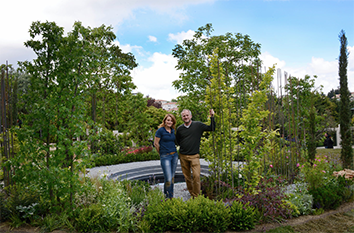June 2019
Catching the light
11/06/19 09:46 Filed in: Gardening
 A perfect contrast – dark tulip Havran absorbs all the light, while the lime green flower of Smyrnium perfoliatum glows and radiates it back. Image courtesy of Alladio Sims Garden and Landscape Design Ltd
A perfect contrast – dark tulip Havran absorbs all the light, while the lime green flower of Smyrnium perfoliatum glows and radiates it back. Image courtesy of Alladio Sims Garden and Landscape Design LtdIf plants’ response to light is key to the design of a garden, then a successful scheme must understand how to respond by ‘lighting up’ plants and using them to their best effect. Bella Alladio of Alladio Sims Garden Landscape Design Limited explains how to do just that.
It’s hard to resist colour, mainly because our brains respond so strongly to it. We are wired to receive colour and in our gardens this is more noticeable than elsewhere: flowers catch our attention first and stop our gaze more than anything else. Yet colour is not as solid as we might think, instead it’s ever changing and infinitely complex because it’s made out of light, and its variety of hues and tones change in relation to the quality of the sunlight.Growing up in Italy, I was blessed by month after month of relentless powerful sunlight and bottomless blue skies and I soon learnt to appreciate the colour-enhancing properties of the sun, especially on warmer hues and vibrant combinations. Yet in the harsh light of a hot summer afternoon these tones would sometimes become overbearing. This extreme light context contrasts with the soft colour combinations of a classic English border illuminated by the gentle diffused light of a misty or cloudy sky; here the subtlety of each hue is allowed to show itself – soft pinks and pastel tones glow, coppery hues are warm under grey skies while whites gather what light there is and sparkle against green foliage foil.
This dynamic reaction to light shows just how the process of designing a successful garden must start by observing local colours and the way in which they behave in local natural light conditions, in an attempt to recreate some of this magic within the garden. Colours look different in different climates and not all climates support the same tones, so better to be restrained in choosing and using them, like in so many classic Italian gardens or in the famous English ‘White Garden’ of Sissinghurst, where a limited mix of grey, green and white interacts creating sheer light magic based on the principle set out by its designer, Vita Sackville-West: “Any colour, as long as it’s white.”
Attempting to design a garden closely obeying the criteria set out by a colour wheel has often proved disappointing. Of course, adding colourful accents can be fun and can help to introduce brief moments of delight, but when this is not connected to the bigger picture, or it’s not bold enough to make a statement, it can appear too harsh and fail to work overall. A good approach would be to observe how colours behave locally and how they help to form specific moods or create drama, and to try and replicate some of those aspects within the garden.
Indeed understanding the continuously evolving light properties of a specific garden will allow a designer to play with light and dark, and the full spectrum of hues available within different times of the day, different seasons and throughout the evolution of a plant life cycle. The vivid light shining through a daffodil in the pale rosy morning glow takes on red tones in the evening, while the golden rich tones of the autumn sun make purple asters and the yellow of maturing grasses glow. With the passing of time light changes, and these changes allow plants to illuminate dark corners, bounce light from under tree canopies, shimmer against the evening sunset and look vibrant and alive when backlit.
A silver leaf plant like Salvia argentea, whose woolly leaves shine even on the dullest of days, is capable of radiating light as soon as the sun hits it and therefore is best placed where the sun shines directly on it. The variegation and white flowers on shrubs like Pittosporum tenuifolium variegatum, Choisya or Osmanthus burkwodii will light up even the darkest of corners, bouncing the diffuse light back into the landscape. A dark leaf such as that of an Asarum will absorb light to make the best of its shady growing condition, but in early morning light its glossy surface will be reflective.
A golden or yellow leaved plant will work in much the same way as a white flower would, radiating light back from its leaves, but adding a golden glow. Hackonechloa macra aureola is one such plant, forming a divine mass of luminous golden blades in the under storey of trees or other dry and inhospitable shady spots which appears magical when early morning or evening light goes through it. Ferns behave in a similar way too. When such simple and beautiful golden luminescence is available the plant palette can be kept simple.
A good example of trees that display similar translucent properties when light touches them, glowing through their leaves, are Japanese maples or heart shaped Cercidiphyllum japonicum. Observed in direct sunlight, a purple leaved maple will absorb the light and be a dark hole in the landscape, but carefully positioned with the sun behind it, its leaves will appear vibrant and alive with multiple tones as light passes through the layers of leaves.
Plants with fine textures such as feathery Stipa tenuissima or fennel are also particularly stunning when backlit, as their fronds trap the light creating a wonderfully luminous radiance. They require careful placing in a location where the early morning sun or mellow evening light backlights them as we stand against them. Mixed with strong architectural shapes and bold silhouettes such as the elongated swords of a phormium or the vertical blades of an iris with their dramatic shadows and sculptural presence, the result can produce a striking mix of exuberant and rigid forms softened by flexible and radiant plumes.
Difficult as it may be, designing a garden with these fleeting but wonderful light effects in mind is to try and recreate beauty, and whilst it’s true that plant behaviour will somehow always be partially beyond our control, there is a sense of real accomplishment and satisfaction when such moments of joy are achieved.
 Jon and Emanuela in the show garden they created for the Istanbul Flower Festival in 2016
Jon and Emanuela in the show garden they created for the Istanbul Flower Festival in 2016Profile: Alladio Sims
Alladio Sims Garden Landscape Design Ltd was established in 2015 after Jon Sims and Emanuela Alladio collaborated on a Silver Gilt winning show garden at RHS Hampton Court Palace Flower Show. The two directors continue their collaborative approach throughout their practice with Jon’s background in interior architecture giving distinctive spaces and Emanuela’s passion for plants and photographic eye adding great texture and contrast.
essence info
Alladio Sims Garden Landscape Design Limited
Unit C Willow House, Dragonfly Place, London SE4 2FJ
Website: www.alladiosims.co.uk
Email: hello@alladiosims.co.uk